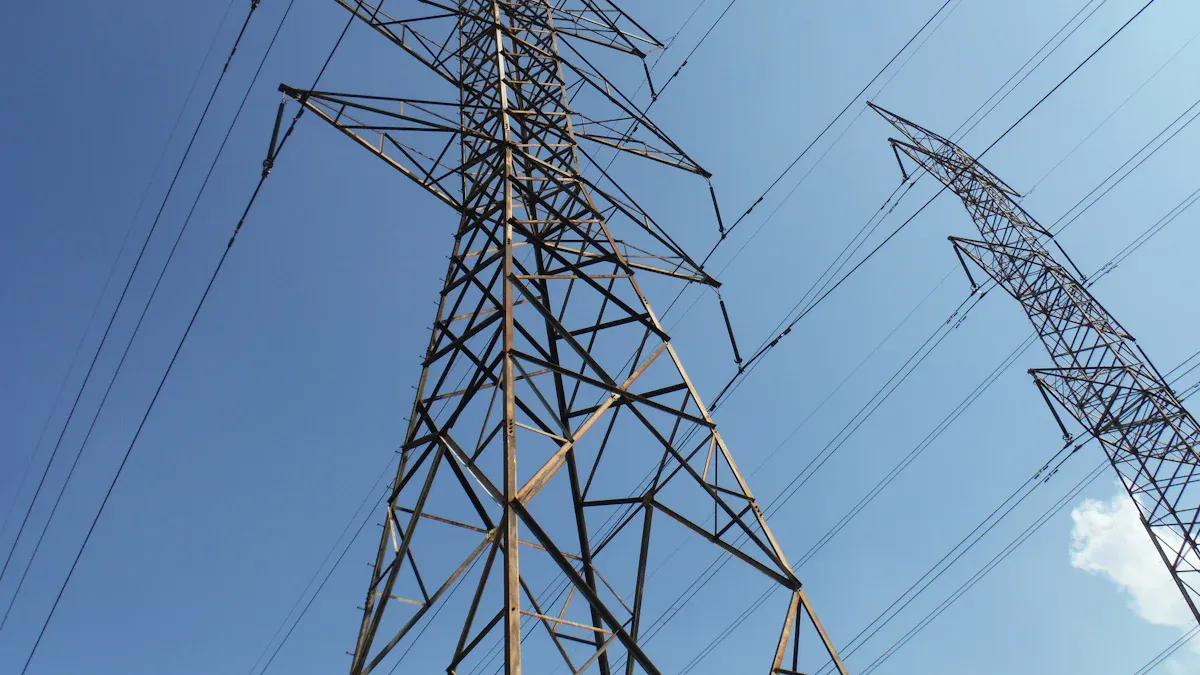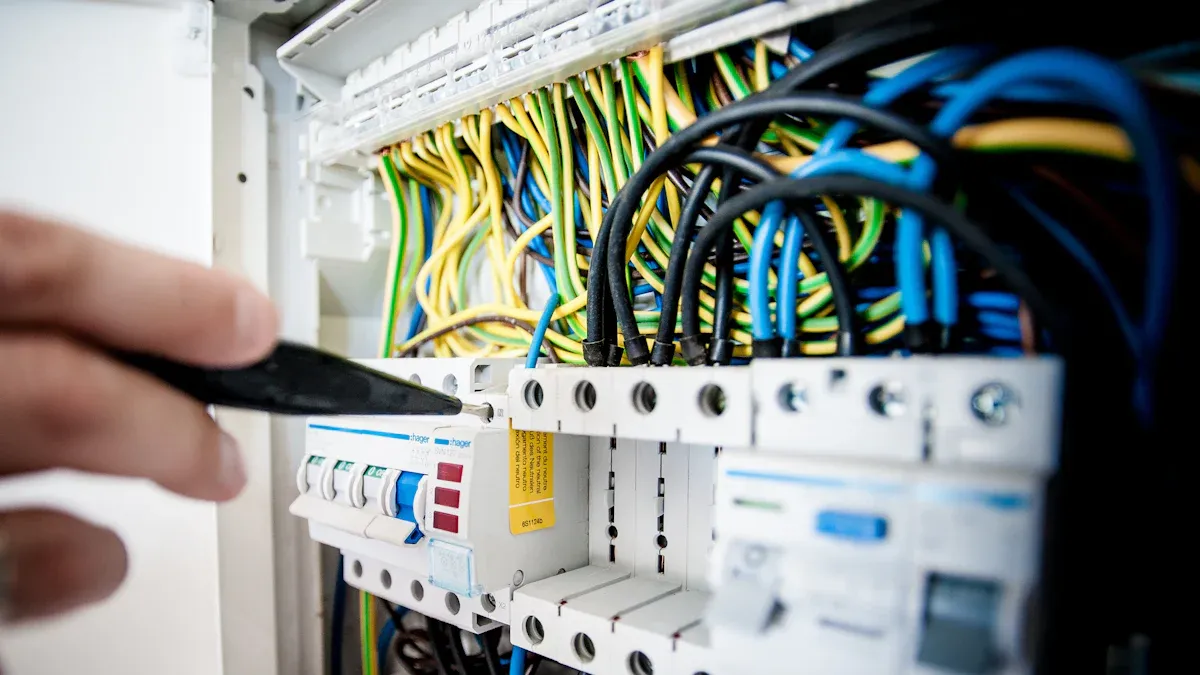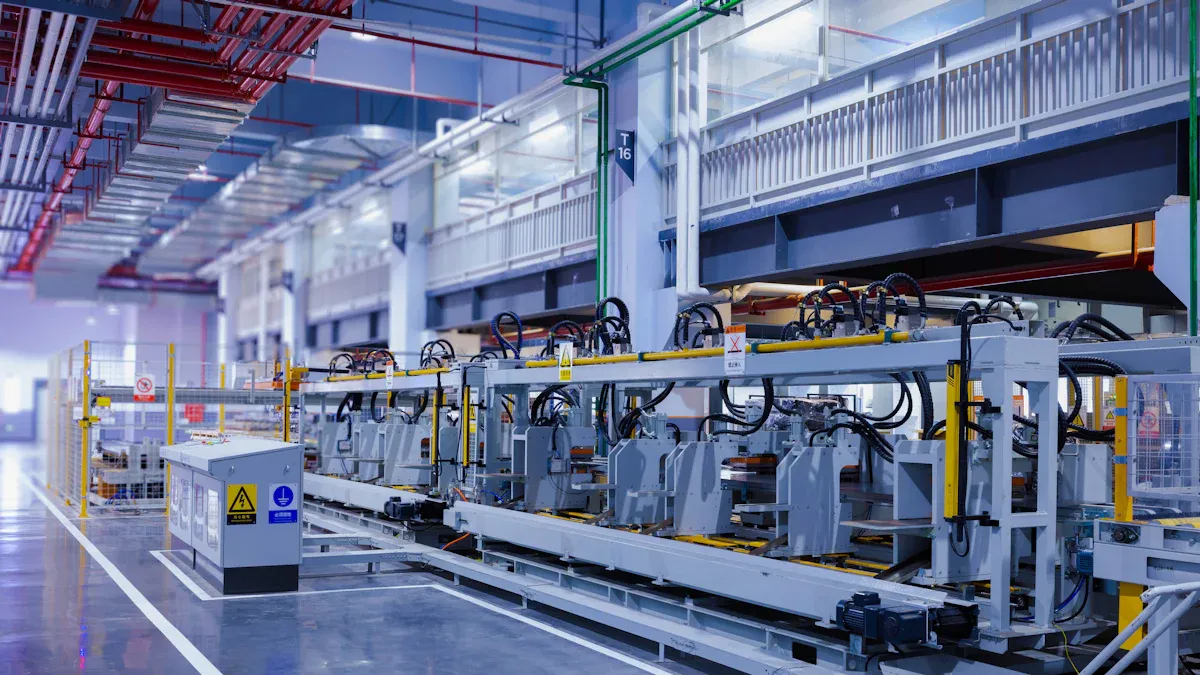What Is a DC Rectifier System and Its Role in Power Conversion?

A DC rectifier system is a device that converts alternating current (AC) into direct current (DC). This conversion plays a critical role in modern electrical systems where stable DC voltage is essential. You encounter rectifiers in applications ranging from powering laptops and smartphones to supporting renewable energy systems. Industries like telecommunications and automotive rely on these systems to achieve high conversion efficiency and ensure reliable operation. For example, direct current data centers and electric vehicle infrastructure depend on rectifying the input voltage to maintain an uninterruptible power supply. By understanding what is a rectifier used for, you can see how it supports power supplies across various sectors.
Key Takeaways
DC rectifier systems change alternating current (AC) into direct current (DC). They give steady power to devices like phones and electric cars.
Important parts of a rectifier are transformers, diodes, capacitors, and voltage regulators. These parts work together to make power conversion efficient.
Full-wave rectifiers work better than half-wave ones. They use both parts of the AC cycle for smoother and stronger voltage.
DC rectifiers are important in renewable energy systems. They handle power from solar panels and help store energy well.
Using DC rectifiers cuts energy waste. This saves money and improves how things like data centers and telecom systems work.
How Does a DC Rectifier System Work?

AC to DC Conversion Process
The AC to DC conversion process is the foundation of a dc rectifier system. Alternating current (AC) flows in both directions, while direct current (DC) flows in only one direction. A rectifier circuit transforms AC into DC by allowing current to pass through in a single direction. This process involves several steps:
A transformer reduces the high AC voltage (e.g., 230V) to a lower level, such as 13V.
A bridge rectifier, composed of four diodes, converts the AC into pulsating DC.
A filter capacitor smooths the pulsating DC, creating a more stable output.
Finally, a low-dropout regulator (LDO) ensures the voltage remains consistent.
While this process is effective, transformer-based converters often face challenges. They can lose energy as heat, reducing efficiency. Additionally, transformers are bulky and expensive, accounting for over 60% of the manufacturing cost. These factors make compact and efficient designs more desirable in modern applications.
Key Components of a DC Rectifier
A dc rectifier relies on several critical components to perform its function. Each part plays a unique role in ensuring efficient power conversion:
Transformer: Steps down or steps up the AC voltage to the desired level.
Rectifier Circuit: Contains diodes that convert AC to DC by allowing current to flow in one direction.
Filter Capacitor: Smooths the rectified DC voltage, reducing fluctuations.
Voltage Regulator: Maintains a stable output voltage, even when input conditions vary.
These components work together to deliver a reliable and steady direct current output. Without them, the rectifier system would fail to meet the demands of modern electrical devices.
Role of Rectifier Diodes in Rectification
Rectifier diodes are the heart of any rectifier circuit. They ensure that current flows in only one direction, converting alternating current into direct current. This unidirectional flow is essential for powering devices that require stable DC voltage.
Rectifier diodes must handle high current levels to maintain efficiency and reliability. Full-wave rectifiers, which use the entire AC cycle, achieve higher efficiency compared to half-wave rectifiers that utilize only half the cycle. The diodes in a bridge rectifier configuration are particularly effective, as they maximize the use of the AC input while minimizing energy loss.
Types of DC Rectifier Systems
Understanding the types of rectifiers helps you choose the right one for your application. Each type has unique characteristics that make it suitable for specific tasks.
Half-wave Rectifiers
Half-wave rectifiers are the simplest type of rectifier. They use a single diode to convert AC into DC by allowing current to flow during only one half of the AC cycle. This results in a pulsating DC output. While their design is straightforward, their efficiency is relatively low.
Efficiency (η) is calculated as the ratio of output DC power to input AC power:
Example: For an output power of 15 watts and input power of 40 watts, the efficiency is approximately 37.5%.
Another example yields 37.2% efficiency under different conditions.
Due to their limited efficiency, half-wave rectifiers are best suited for low-power applications, such as small household devices.
Full-wave Rectifiers
Full-wave rectifiers improve upon the limitations of half-wave rectifiers by utilizing both halves of the AC cycle. This results in a higher average DC output voltage and smoother current flow.
Metric | Full-Wave Rectifier | Half-Wave Rectifier |
|---|---|---|
Average DC Output Voltage | Higher | Lower |
Ripple Frequency | Double input frequency | Same as input frequency |
Efficiency | Higher | Lower |
In industrial applications, full-wave rectifiers are preferred for their ability to handle higher currents and produce stable outputs. They are commonly used in power supplies and motor control systems.
Bridge Rectifiers
Bridge rectifiers are a type of full-wave rectifier that uses four diodes arranged in a bridge configuration. This design eliminates the need for a center-tapped transformer, simplifying the circuit and reducing costs.
Advantage | Explanation |
|---|---|
High Efficiency | Utilizes both halves of the AC cycle, reducing energy waste. |
Higher Output Voltage | Provides a higher DC output voltage. |
Reduced Ripple | Produces smoother output, ideal for sensitive electronics. |
Reliable and Durable | Can function even if one diode fails. |
Bridge rectifiers are widely used in applications requiring high efficiency and reliability, such as power supplies for telecommunications and industrial equipment.
Role of DC Rectifier Systems in Power Conversion
Power Supply Systems
DC rectifier systems play a vital role in modern power supply systems by ensuring efficient and reliable energy conversion. These systems convert alternating current into direct current, which is essential for powering sensitive electronic devices and industrial equipment. By eliminating multiple conversion stages, they reduce energy losses and improve overall system efficiency.
DC power systems are known for their high reliability and efficiency, making them ideal for critical applications. They maintain constant voltage levels, preventing issues like voltage fluctuations and harmonics. This ensures a stable and uninterrupted power supply for your devices.
Additionally, rectifiers simplify voltage regulation and load management, enhancing system performance and protection. This reliability leads to improved uptime and reduced maintenance costs, which are crucial for industries that rely on continuous operation.
Battery Charging Applications
Battery chargers rely heavily on DC rectifier systems to provide the stable and consistent direct current required for charging. Whether you're charging a smartphone, an electric vehicle, or a backup power system, rectifiers ensure the process is efficient and safe.
Rectifier diodes are at the core of this application. They allow current to flow in one direction, ensuring that the battery receives a steady DC voltage. This prevents overcharging and protects the battery from damage. For example, in electric vehicle charging stations, rectifiers convert AC from the grid into DC to charge the vehicle's battery efficiently.
The difference between rectifiers and converters becomes evident in this context. While rectifiers focus on converting AC to DC, converters handle more complex tasks like changing voltage levels or frequencies. This distinction highlights the specialized function of rectifiers in battery charging applications.
Data Center Rectifiers and Industrial Use
Data centers and industrial facilities depend on DC rectifier systems for their power needs. Data center rectifiers ensure a stable power supply for servers and other critical equipment. These systems convert AC from the grid into DC, which is then distributed to various components.
Evidence Type | Description |
|---|---|
Rectifier Transformers Usage | Approximately 65% of the world's industrial DC power systems rely on rectifier transformers for effective power conversion. |
In industrial settings, rectifiers support heavy machinery and automation systems. They provide the high current levels required for these applications while maintaining efficiency and reliability. The use of rectifier diodes in these systems ensures that energy losses are minimized, and performance remains consistent.
Data center rectifiers also play a crucial role in reducing energy consumption. By eliminating unnecessary conversion stages, they enhance efficiency and lower operational costs. This makes them an essential component of modern industrial and data center infrastructure.
Advantages and Applications of DC Rectifier Systems

Efficient Power Conversion Benefits
DC rectifier systems offer significant advantages in power conversion efficiency. They minimize energy losses during the conversion process, making them ideal for applications requiring reliable and cost-effective power. For example, research by Lawrence Berkeley National Laboratory highlights that devices operating on direct current achieve higher efficiency when connected to DC distribution systems. This efficiency translates into tangible benefits, such as reduced power losses of only 2-3%, compared to 10% in AC systems.
Aspect | DC Rectifier Systems | AC Transmission Systems |
|---|---|---|
Power Losses | 2-3% | 10% |
Energy Savings in Buildings | 5% to 20% | N/A |
Energy Cost Savings in Data Centers | 6.1% | N/A |
Annual Electricity Cost Savings | $1.10 per sq. ft. | N/A |
ROI After Implementation | 2 to 5 years | N/A |
In real-world applications, DC rectifiers also improve power savings. For instance, advancements in high-voltage power electronics have achieved 17% efficiency improvements, while reducing losses in intermediate converters has resulted in 36% efficiency gains. These benefits make rectifiers indispensable in modern power systems.
Use in Renewable Energy Systems
DC rectifier systems play a crucial role in renewable energy applications. They enhance the performance of hybrid power management systems that combine solar photovoltaic (PV) panels and battery storage. By integrating a DC-link capacitor and a PI-based hybrid controller, rectifiers ensure efficient power flow management. This setup allows surplus solar energy to charge the battery when demand is low and enables the battery to supply power during periods of insufficient solar generation.
This efficient energy management reduces reliance on traditional power sources and maximizes the use of renewable energy. For example, in off-grid solar installations, rectifiers ensure stable power delivery, even in fluctuating weather conditions. Their ability to handle variable inputs and provide consistent outputs makes them essential for sustainable energy solutions.
Role in Telecommunications and Electronics
Telecommunications and high-tech electronics rely heavily on DC rectifier systems for their power needs. Modern rectifiers feature advanced technologies that improve efficiency and functionality. For instance:
37% of new rectifier units include plug-and-play architecture, simplifying deployment in telecom facilities.
29% of rectifier modules are optimized for ultra-fast EV charging, reducing charge times by 22%.
Over 34% of new systems incorporate digital controls for voltage stability and predictive maintenance.
40% of products released in recent years are 20% smaller, reflecting a trend toward compact designs.
These innovations make rectifiers ideal for powering sensitive electronic devices and critical telecom infrastructure. Their ability to maintain voltage stability and reduce energy losses ensures uninterrupted operation, even in demanding environments.
DC rectifier systems convert alternating current into direct current, ensuring stable and reliable power for your devices. These systems use components like diodes and capacitors to produce a smooth and consistent output. You rely on rectifiers in applications ranging from battery charging to industrial power supplies. Their ability to deliver efficient output makes them essential for modern technologies, including renewable energy systems and telecommunications. By minimizing energy losses, rectifiers improve performance and reduce costs, making them indispensable across industries.
FAQ
What is the main purpose of a DC rectifier system?
A DC rectifier system converts alternating current (AC) into direct current (DC). This process ensures a stable and reliable power supply for devices that require DC, such as electronics, batteries, and industrial equipment.
How does a rectifier differ from an inverter?
A rectifier converts AC to DC, while an inverter does the opposite—it converts DC to AC. Rectifiers are essential for devices needing DC power, whereas inverters are used for applications like powering AC appliances from DC sources like batteries.
Can a DC rectifier system improve energy efficiency?
Yes, DC rectifier systems minimize energy losses during power conversion. By reducing heat generation and optimizing power flow, they enhance efficiency, especially in applications like renewable energy systems and data centers.
Why are bridge rectifiers preferred over half-wave rectifiers?
Bridge rectifiers utilize both halves of the AC cycle, providing higher efficiency and smoother DC output. They also eliminate the need for a center-tapped transformer, making them more cost-effective and reliable for various applications.
Are DC rectifier systems used in renewable energy?
Absolutely! DC rectifiers play a crucial role in renewable energy systems. They convert variable AC from sources like wind turbines into stable DC, ensuring efficient energy storage and distribution in hybrid systems with solar panels and batteries.
See Also
Essential Insights for Newcomers on Telecom Power Systems
Connecting Solar Inverters and Batteries for Telecom Solutions
Methods for Calculating Power Systems and Batteries in Telecom
Key Features of Power Supply Systems in Telecom Industry
Strategies for Maintaining Reliable Power in Telecom Cabinets
CALL US DIRECTLY
86-13752765943
3A-8, SHUIWAN 1979 SQUARE (PHASE II), NO.111, TAIZI ROAD,SHUIWAN COMMUNITY, ZHAOSHANG STREET, NANSHAN DISTRICT, SHENZHEN, GUANGDONG, CHINA


